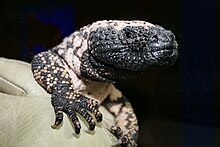Heloderma
| Heloderma Temporal range:
| |
|---|---|

| |
| Gila monster, Heloderma suspectum | |
| Scientific classification | |
| Domain: | Eukaryota |
| Kingdom: | Animalia |
| Phylum: | Chordata |
| Class: | Reptilia |
| Order: | Squamata |
| Infraorder: | Neoanguimorpha |
| Clade: | Monstersauria |
| Family: | Helodermatidae |
| Genus: | Heloderma Wiegmann, 1829 |
| Type species | |
Heloderma horridum
, 1829 | |
| Species | |
| |
Heloderma is a genus of toxicoferan lizards that contains five species, all of which are venomous.[1] It is the only extant genus of the family Helodermatidae.
Description
The genus Heloderma contains the
Venom
The venom glands of Heloderma are located at the end of the lower jaws, unlike
Diet
Helodermatids are
Reproduction
All species of Heloderma are
Taxonomy

| Explanation of the numbers | |
|---|---|
| 1 | late Eocene (approx. 35 million years) |
| 2 | late Miocene (approx. 10 million years) |
| 3 | Pliocene (approx. 4.4 million years) |
| 4 | Pliocene (approx. 3 million years) |
Family Helodermatidae
- Genus Heloderma
- H. suspectumCope, 1869; Gila monster
- H. horridum (Wiegmann, 1829); Mexican beaded lizard
- Bogert& Martin Del Campo, 1956; Rio Fuerte beaded lizard
- H. charlesbogerti Campbell & Vannini, 1988; Guatemalan beaded lizard
- Bogert& Martin del Campo, 1956; Chiapan beaded lizard
Members of the genus Heloderma have many extinct relatives in the Helodermatidae whose evolutionary history may be traced back to the

The type species is Heloderma horridum, which was first described in 1829 by Arend Wiegmann. Although he originally assigned it the generic name Trachyderma, he changed it to Heloderma six months later, which means "studded skin", from the Ancient Greek words hêlos (ηλος)—the head of a nail or stud—and derma (δερμα), meaning skin.[12]
Conrad, 2008 and Estes et al., 1988 (using morphological data) places Helodermatidae within
However, Estes et al., 1988 understood Helodermatidae as having split earlier from Lanthanotus and Varanus, whereas Conrad, 2008 groups them at the same branch point.In contrast, molecular studies have identified Heloderma as being within Anguioidea along with Anguidae and Xenosauridae, but specifically sister to Anguidae.[15][16]
Venom
Venom production among lizards was long thought to be unique to this genus, but researchers studying venom production have proposed many others also produce some venom, all placed in the clade Toxicofera, which includes all snakes and 13 other families of lizards.[17] However, except for snakes, helodermatids, and possibly varanids, envenomation is not considered medically significant for humans

In captivity

H. horridum, H. exasperatum, and H. suspectum are frequently found in captivity and are well represented in zoos throughout much of the world. The other two species of Heloderma, H. alvarezi and H. charlesbogerti, are extremely rare, and only a few captive specimens are known.
Gallery
- Heloderma suspectum in captivity
-
Heloderma suspectum with 4 eggs
-
Heloderma suspectum with 6 eggs
-
Gila monster hatching
-
Group of young Gila monsters

References


- ^ "POISINDEX(R) TOXICOLOGIC MANAGEMENTS Topic: GILA MONSTER (HELODERMA SUSPECTUM)".
- ISBN 978-3-030-71302-7– via Google Books.
- ISBN 978-0-08-047609-4– via Google Books.
- ^ C. M. Bogert, R. M. Del Campo (1956). "The Gila Monster and its Allies. The relationships, habits, and behavior of the lizards of the family Helodermatidae". Bulletin of the American Museum of Natural History. 109: 1–238.
- ^ Beck, D. D. (2005). Biology of Gila Monsters and Beaded Lizards. University Press of California.
- ISBN 978-3-89973-441-6.
- ^ ISBN 0-12-178560-2.
- ^ Richard L. Cifelli, Randall L. Nydam. 1995. Primitive, helodermatid-like platynotans from the Early cretaceous of Utah. Herpetologica. 51(3):286-291.
- ISBN 978-0-7817-2845-4.
- ISBN 0-253-34366-6.
- ISBN 0-7137-2357-2.
- ^ Wiegmann, A.F.A. (1829). "Über die Gesetzlichkeit in der geographischen Verbreitung der Saurier". Isis. 22 (3–4). Oken: 418–428.
- S2CID 84301257.
- ISBN 9780804714358.
- PMID 22809723.
- PMID 15545252.
- ^ .
Fry, B.; et al. (February 2006). "Early evolution of the venom system in lizards and snakes". Nature. 439 (7076): 584–588. S2CID 4386245.

Notes
- Ariano-Sánchez, Daniel (2008). "Envenomation by a wild Guatemalan beaded lizard Heloderma horridum charlesbogerti". Clinical Toxicology. 46 (9): 897–899. S2CID 22173811.
- Ariano-Sánchez, D. & G. Salazar. 2007. Notes on the distribution of the endangered lizard, Heloderma horridum charlesbogerti, in the dry forests of eastern Guatemala: an application of multi-criteria evaluation to conservation. Iguana 14: 152–158. [1]
- Ariano-Sánchez, D. 2006. The Guatemalan beaded lizard: endangered inhabitant of a unique ecosystem. Iguana 13: 178–183. [2]
- CONVENTION ON INTERNATIONAL TRADE IN ENDANGERED SPECIES OF WILD FAUNA AND FLORA Archived 2018-09-30 at the Wayback Machine. 2007. Resume of the 14th Convention of the Parts. The Hague. The Netherlands.

External links
Schwandt, Hans- Joachim www.heloderma.net 2006 in 6 languages
Further reading
- C. M. Bogert, R. M. Del Campo (1956). The Gila Monster and its Allies. The relationships, habits, and behavior of the lizards of the family Helodermatidae. Vol. 109. Bulletin of the American Museum of Natural History. pp. 1–238.
- Beck, D. D. (2005). Biology of Gila Monsters and Beaded Lizards. London: University Press of California.
- Schwandt, Hans-Joachim (2019). The Gila Monster Heloderma suspectum. Frankfurt/Main: Edition Chimaira. ISBN 978-3-89973-441-6.
| Wikispecies has information related to Heloderma suspectum |
- About Beaded Lizards Archived 2015-02-15 at the Wayback Machine
- Heloderma information
- Family Helodermatidae (Gila Monsters) Archived 2010-07-15 at the Wayback Machine




